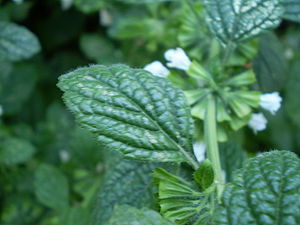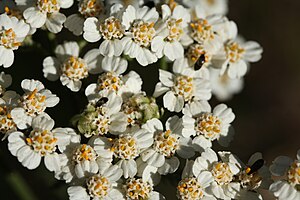An olde fashioned favourite tea that is used for sudden chills, chills from a feverish state or fevers is equal amounts of mint, elder flower and yarrow. If you happen to have a copy of Matthew Wood’s Earthwise Herbal, you will read that “mint tea was used during the terrific grippe epidemics of 1838 and 1836.”*
I would really love to know when this combination was discovered. ?áI would like to give you some kind of a quaint story about a particular person who looked quite hobbity,?álived in a hollowed out tree and happened to come up with this recipe. Alas, I don’t have such a story. ?áAll I know is that it is an olde recipe traditionally used for colds, flus, the early stages of a cold, fevers and chills.
Let’s look at why each of these ingredients might be helpful. ?áTry to keep in mind that this is not the only way these plants are used, it is not even the most popular way they are used. ?áI am simply outlining why this formula might be of use. ?áIf you prefer not to use herbs for healing or if you have trouble finding these herbs, you can always try food as your first medicine. ?áI made a list of common foods useful for colds and flus a couple weeks ago.
Peppermint (Mentha piperita) is considered to be?áat first warming, then cooling.?á It is also stimulating and drying.
Try a cup for yourself and pay attention to how you feel. It has a long history of use.?á Even Dioscorides** put a spray of mint in his cloak to raise his depressed spirits. Peppermint is useful as a diffusive circulatory stimulant, antispasmodic, carminative, nervine, anti-emetic (in normal doses) and a weak anodyne. It is antiviral, antifungal and antibacterial. Peppermint helps to relax peripheral blood vessels, calms muscle spasms and dries dampness.
Elder flower (Sambucus nigra, S. canadensis) According to the KingÔÇÖs Dispensary, elder flowers are diaphoretic and gently stimulating when used as a warm infusion.
In a cold infusion, elder flowers are diuretic, alterative, and cooling.?á Both hot and cold infusions will help the body to release toxins. ?áIn 1653, Culpeper claimed that elder flowers are beneficial for edema (the word he uses is dropsy) and will aid in cleansing the blood, clearing the skin and will aid the liver and spleen functions.*** ?áElder flowers are also antiviral, anticatarrhal and antispasmodic.
Yarrow (Achillea millefolium) is in the Aster family.?á And as such, it is considered to be chemically complex.?á This chemical complexity makes yarrow a normalizer, particularly in the circulatory system or when dealing with blood.?á In the context of colds and flus, fevers and chills, yarrow helps as a diuretic and a diaphoretic, encouraging the removal of waste from the body and movement of the blood to the surface of the body.?á It will gently relax the body while aiding liver function.?á When you drink yarrow tea hot, it will increase the body temperature and make you sweat, thus acting as a diaphoretic.?á It is also anti-inflammatory, antispasmodic, bitter digestive tonic, antiseptic, antifungal, hypotensive, carminative and peripheral vasodilator.
How to prepare this classic combination? Boil a cup or two of water. ?áAdd 1 teaspoon of the combination of equal parts peppermint, elder flower and yarrow. ?áLet this steep for 15 minutes in a covered vessel, strain the tea and then drink. And, perhaps put on a sweater or cover up with a blanket, take a nap or read a book. ?áRelax!
Tammy Schmidt, Montreal
*Wood, Matthew. (2008)?áEarthwise Herbal; A Complete Guide ?áto Old World Medicinal Plants. Berkeley, CA: North Atlantic Books, 345.
**Bartram, Thomas. (1995) Bartram’s Encyclopedia of Herbal Medicine. New York: Marlowe and Company,?á331.
*** Culpeper, Nicolas. (1995) Culpeper’s Complete Herbal. Hertfordshire: Wordsworth Editions Limited.




Comments
One response to “got the chills?”
[…] move it fleurbain verdant life in the city « got the chills? […]